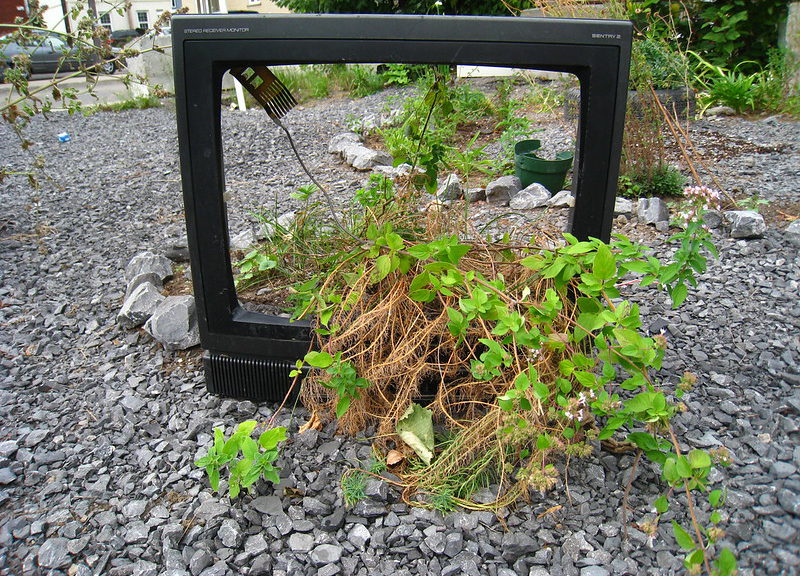
THE BEAUTY REBELLION (Guerilla Gardening)
It is heartening for me to see the world-wide burgeoning of another sort of rebellion against the very real effects of the post-modern aftermath of our narcissistic phase of dominion and domination over nature, where we humans felt entitled to willy-nilly pave over the world and dump our stuff all over the place to make yet another ugly.
They call it “guerilla gardening” and it continues to expand all over the globe.
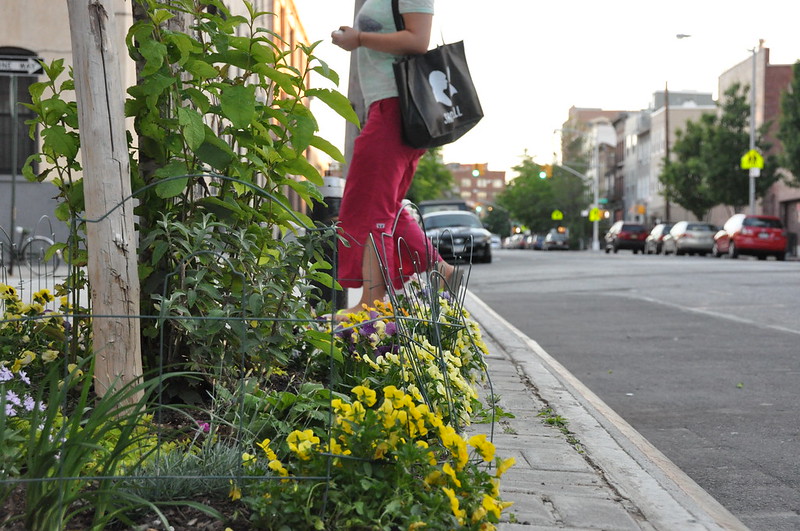
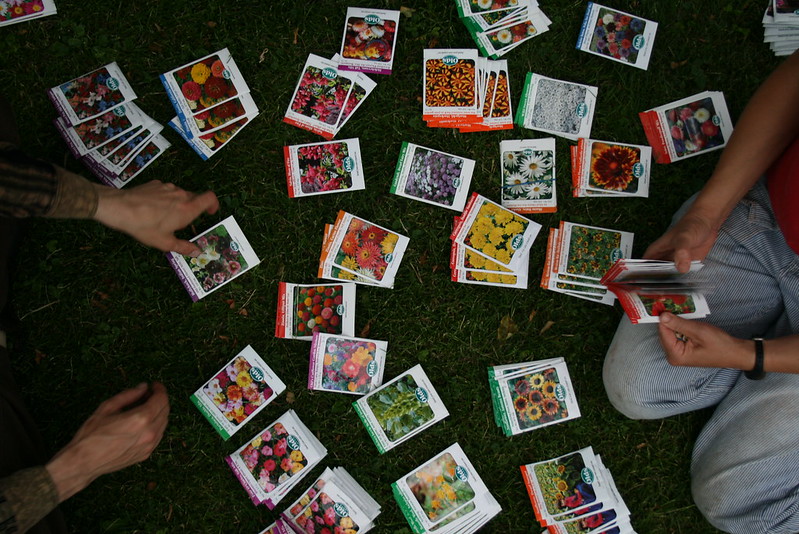
It’s a “movement,” they say.
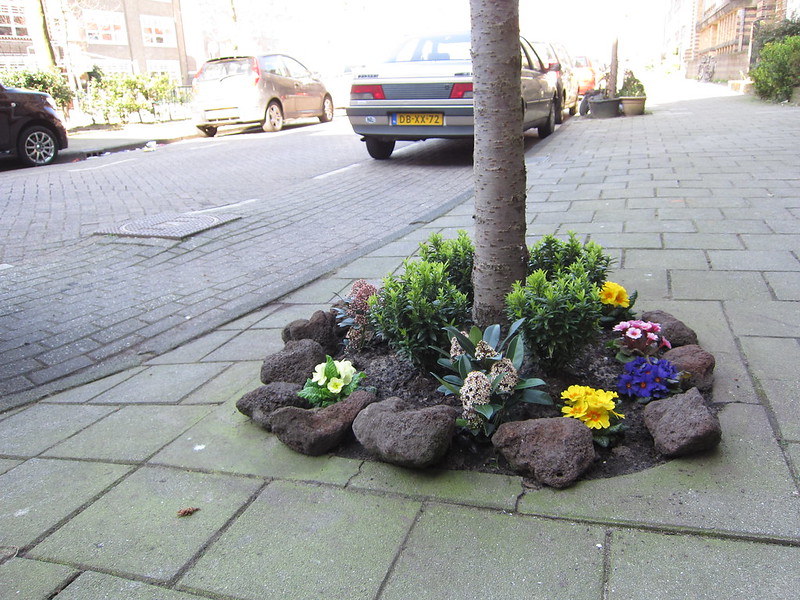
Individual Green insurgents add their bits as well. Mostly, it seems to me, they giggle a lot.
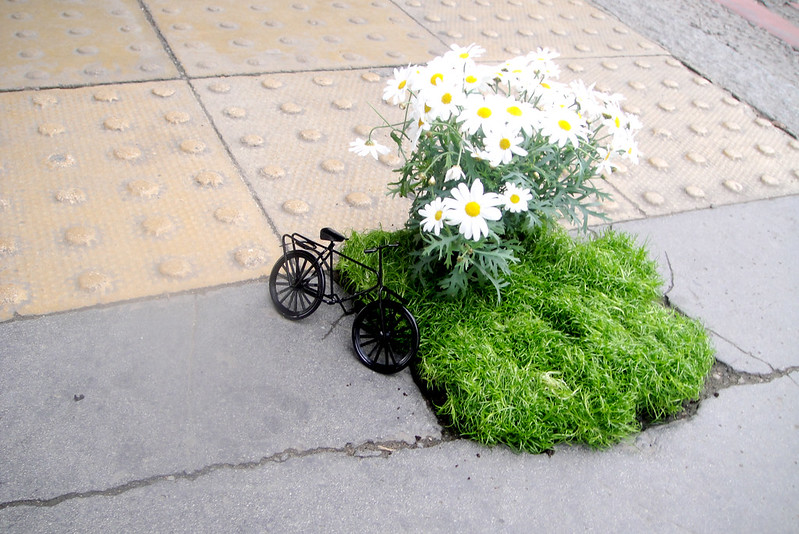
WHAT’S A GUERILLA GARDENER?
The best definition for the term I found was in life-coach Chris Baréz-Brown’s book, WAKE UP: A Handbook for Living in the Here and Now (54 Playful Strategies to Help You Snap Out of Autopilot).
He says that guerilla gardening is “provoking change by bringing nature to spaces where it doesn’t exist, such as an inner-city abandoned plot.” The key, he says is not asking for permission to plant.

The phrase, “guerilla gardening,” originated in the 1970s. Most people credit the first recorded use of the term to Liz Christy and her Green Guerilla group who transformed a derelict private lot in the Bowery Houston area of New York into a garden.
The garden’s still cared for by volunteers but now enjoys the protection of the city’s park department.

Supposedly the guy is “Britain’s 24th most influential gardener” — which is saying something in a country that is teeming with plant-lovers and People of the Garden.
In the following 2008 video, “Guerilla Gardening, Richard Reynolds” published by Bloomsbury Publishing, Reynolds and his crew are stopped by police officers from completing their mission of beautifying yet another neglected urban spot.
They leave the scene, but then, in true guerilla fashion, they come back to finish the job.
Reynolds’ website, Guerilla Gardening.Org,which he began in 2004 as a logbook of what he calls his “illicit cultivation” around London, has gone global.
The website provides a wealth of information about what Reynolds calls “gardening without boundaries.” It has become a gathering place, a hub for information exchange among the global community of those who follow the many ways of ninja-gardening.
Reynold’s book, ON GUERILLA GARDENING: The Why, What, and How of Cultivating Neglected Public Space, has been translated into several languages and is the default go-to manual and manifesto, it seems.
WHY DO THEY DO IT?
Reynolds gave a talk at TEDxItaewon in Seoul, Korea in 2012 that apparently inspired a whole slew of gardening efforts outside boundaries in South Korea. (You can click the button below to hear the full talk.)
In his talk Reynolds highlights three reasons gardeners go guerilla:
- for the sheer joy of gardening
- for the social aspects of the activity
- for public expression (either aesthetic or in protest of public policies)
Reynolds started out in it because he was a country-bred gardener stuck in a city apartment and he missed being able to indulge his need to play with plants and grub around in the mud.
He quickly gathered helpers and followers as his gardens grew and grew, tapping into the social potential of the thing.
In the course of things, he also began using the guerilla gardening for the third mission of the true guerilla gardener — for protest, for advocacy and so on.
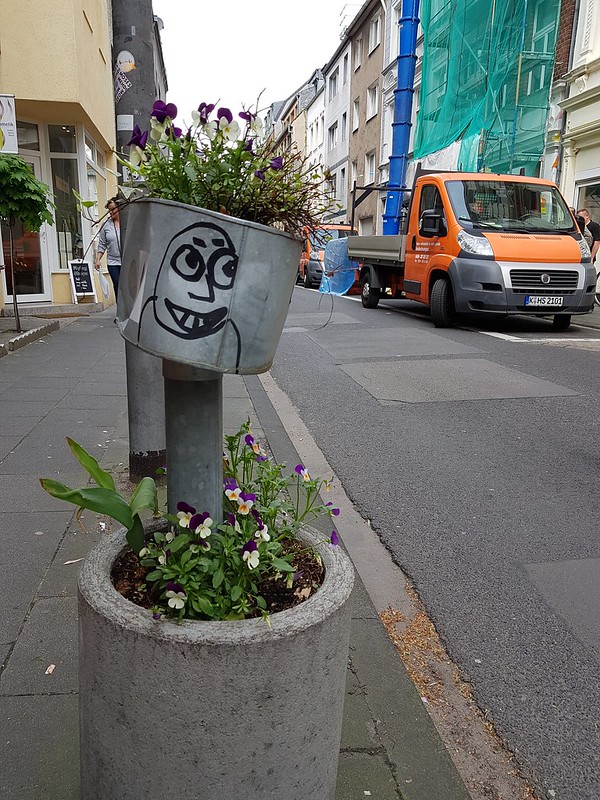
THE GARDEN OF EDEN GOES DOWN
And while Reynolds does not say it, gardening on land you don’t own means your access to the gardens you create can be taken away by the people who do own the land.
For real, these gardens without boundaries can only exist as long as they do not impinge on or interfere with somebody else’s objectives, purposes, development plans or divergent visions. Sometimes they are destroyed.
One of the most spectacular falls from grace involved the world-famous New York landmark, Adam Purple’s Garden of Eden, which existed from 1975 to 1986 behind the tenement building where he lived at 184 Forsyth Street in Manhattan’s Lower East Side.
Purple was born David Lloyd Wilkie. Among his many eccentricities was his penchant for always wearing purple. He did like to garden.
The site where he made his garden had been buried under the debris and rubble from the demolition of two neighboring tenement buildings. He was determined to make a garden where the children could play.
As he cleared away nearly 5,000 cubic feet of debris using only raw muscle power and the simplest tools, Purple also created topsoil from materials he found at the site and around the city.
Almost every day while he was working on preparing the garden, he would make a seven-mile round trip to Central Park on his bicycle to pick up 60 pounds of carriage-horse manure. He added it to his compost pile.
He repurposed the bricks and building materials from the demolished buildings around the site, using them to make garden paths and create planting beds.
Purple’s Garden of Eden was a series of rings of plant beds that expanded further and further outward as more buildings around the site were torn down. At the center of the garden he placed a double Yin-Yang symbol.
The design was full of mathematical and magical mana that Purple was convinced would help the garden keep on expanding outward as the ugly buildings around it came tumbling down.
By the early 1980s, the garden had grown to a whopping 15,000 square feet. It became a safe haven for the community and produced food as well.
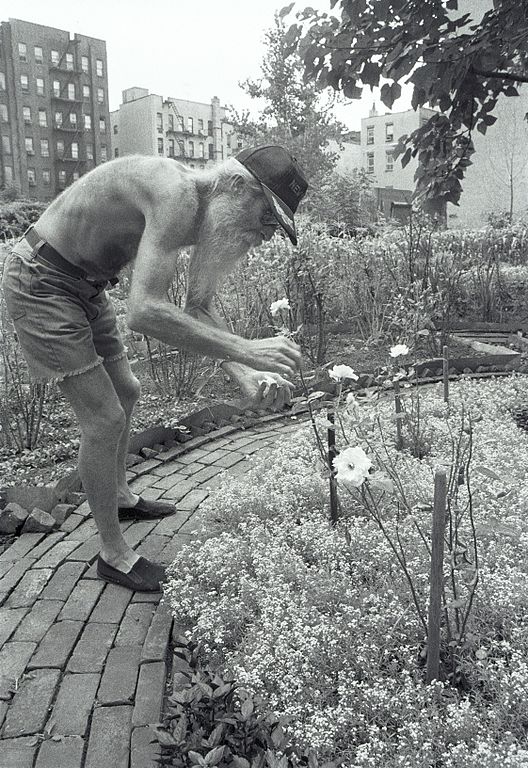
People flocked to the Garden to help maintain it and to enjoy the beauty of what had become a beloved landmark in the Lower East Side.
The city of New York never officially recognized Purple’s garden. Other local parks were clearly marked on official city maps. The Garden of Eden space was always labeled as “vacant”.
On January 8, 1986, the Garden was demolished by bulldozers in just 75 minutes to make way for a federally funded housing project, despite protests, pleas and support from the community and from prominent New Yorkers.
The housing project did not include space for the Garden. It did not include an apartment for Purple and his family.
A remarkable short film, “Adam Purple and the Garden of Eden” was put together by Amy Brost and Harvey Wang in 2011. It was published on YouTube by travelinglight 56. The film features Purple narrating his story and film and photographs taken by Wang, a photographer who documented Purple’s efforts.
SPEAKING OF CABBAGES, KINGS, AND COMMUNITY
In 2012 Te Papa Tongarewa – Museum of New Zealand, the county’s foremost cultural institution, acquired the photographs and documentation of a unique community art project in Wellington, New Zealand that in 1978 was part protest, part urban guerilla garden, part conceptual sculpture, and part community participation project.
It was formally known as “A Vacant Lot of Cabbages.” The neighbors just called it the cabbage patch.
The museum’s curator Sarah Farrar called it “an important moment in New Zealand’s art and social history.”
To view some of the pictures of the work, click on the button below.
The garden was put together by artist Barry Thomas with help from his friends (most of whom were members of an art co-op in the city) on the demolished Duke of Edinburgh/Roxy Theatre site in downtown Wellington that had sat empty for two and a half years.
The neighborhood was disgusted that the owners of the lot apparently couldn’t manage to care for their land. It looked very bad.
Barry was not happy that in all probability the site would be used for just another mundane commercial building. He wanted to point out to the people-in-charge that Wellington has few public parks.
Together, Barry and his friends — guerilla gardeners all — cut the fence to gain access into the privately owned vacant site and trucked in topsoil. They constructed a planter bed and planted 180 cabbages to spell out the word “CABBAGE”.

The artist, when interviewed, invited the neighborhood to do whatever they wanted with the cabbages in the cabbage patch. “Leave them, steal them, run them over with motorbikes” were his suggestions.
He told them that whatever the community did, it would be “part of the art because it’s a reflection of our culture…lt’s a unification of nature with the culture of our society.”
The community responded. The local butcher loaned a hose so that neighbors could water the cabbages and keep them growing.
Over the next few six weeks, as the cabbages grew, the patch was augmented with couches, a gravestone, a toilet, a bed, and a television. One guy plugged a mainframe computer into the cabbage. Somebody else spent over two hours perched on a ladder and bolting a monocycle onto an adjacent wall.
The site became known locally as “the soapbox art corner” and many people used the opportunity to voice or present their own protests. Informal meetings, pop-up performances, events and arts activities happened there every day. It quickly became a gathering place for the neighborhood.
Among the many acts of public expression was a massive papier-mâché pink pig emblazoned with the words, “Media, media expose the pig” that was put together by a Wellington women’s group and targeted the right wing Prime Minister Robert Muldoon.
Graffiti around the site promoted concerns about the (then current) occupation of Maori land in Auckland at Bastion Point.
Meanwhile, two chemists from Victoria University tested the growing cabbages for lead content and pronounced them fit to eat.
When the City Council and the site’s owner decided to clear the site (for public safety, they said), they left the monocycle on the wall and the original cabbage patch. This kept the people coming back to see what would happen next.
While all of this was going on, the artist partnered with a landscape architect to obtain funding from the Commission for the Environment to help pay for a last, week-long festival on the site. They invited the city to share free coleslaw during a week of art activities and all kinds of oddball creative moments.
Called “The Last Roxy Show” the event included poetry readings, performances, and art installations by other artists as well. High school and college art students, guided by a couple of artists, painted large murals, most of them attesting to the value of indigenous forests.
Actor Sam Neill put together a documentary of the festival that included a scene with Barry Thomas dressed in a cassock with his face painted half black and half white as he ceremoniously harvested the cabbages and burned them in a “phoenix gesture.”
“A Vacant Lot of Cabbages” has also been recognized in the country’s online encyclopedia, Te Ara and in an edited art book WELLINGTON: A City for Sculpture from Victoria University Press. They say that no other New Zealand art project has resulted in such a large body of media documentation being collected by the Te Papa Museum.
According to one analysis, the work highlighted the value of the creative use by artists of vacant space and that had a number of subtle side-effects that flavors life in Wellington.
Because of the guerilla-made cabbage patch, there is now a special government-run liaison program in Wellington that helps artists cheaply use otherwise un-rentable vacant space to stimulate economic and cultural activity.
The patch also inspired a long chain of projects by the Wellington City Council that started with the Wellington City Council’s Summer of ’79.
The summertime celebration grew into the “People in the Parks” program which employs hundreds of artists. Thousands of Wellingtonians enjoy activities with artists each summer as a result.

ONE MORE TAKE
And then there is this YouTube video: “Vigilante Gardener” published by Todd Bieber in 2011. It chronicles the first-time efforts of a wanna-be guerilla gardener in Brooklyn, New York.
There doesn’t seem to be a way to find out the rest of the story. Enquiring minds probably want to know what happened with that garden. I wasn’t successful in tracking it down.
Ah, well. After all the hoo-hah and hoorah of the previous examples, it seemed like a good reality check.
A SEED BOMB RECIPE
People who’d like to start smaller than taking on a full-blown gardening project, might want to consider putting together seed bombs, suitable for tossing into vacant lots that need a little flower power.
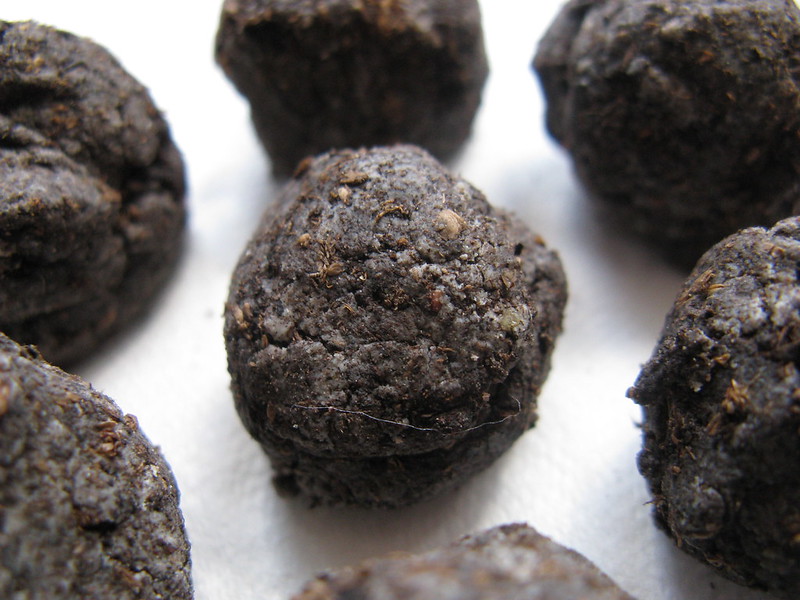
This one says to use:
- 5 parts of some sort of dry clay (usually potters clay or clay powder),
- 3 parts compost
- 1 part seed for plants that are native or noninvasive to your area
You mix all of the dry ingredients together until well-mixed and then add 2 parts of water poured into the dry mix in small increments.
You keep mixing the water into the dry ingredients and then you squish it with your hands until it reaches a doughy consistency that isn’t sticky or wet to the touch.
You roll a small amount of the clay mix into marble-sized balls between your palms, making sure the sphere is smooth and unbroken. (You don’t want any cracks in the thing.
You set the bombs in the sun to dry for at least 24 hours.
After that, they are ready to throw around. Try to avoid jettisoning them when there is a drought. They do need water to grow.
I also found one unusual kid-craft project that’s detailed in this YouTube video: “How to Make Seed Bombs | Seed Balls | Craft Idea DIY” published in 2014 by Emilie Lefler.
I like that it just uses paper. (As a former paper artist, I am fond of that material.) Another plus is that the paper bombs do break down more quickly than their clay cousins.
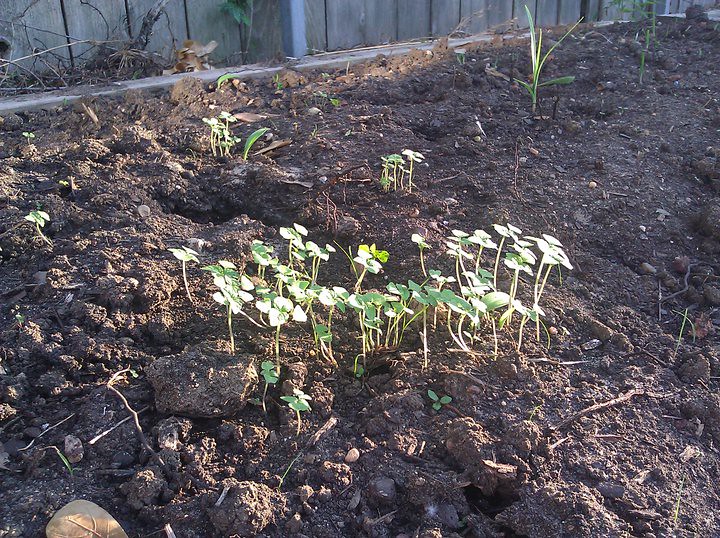
BUTTERFLY DANCE
Two butterflies dance
Among jatropha tree flowers,
Orange and black flittering
Among the red and green.
They sip the cups of nectar
Then dance together
Twirling like autumn leaves
That never fall to the ground.
My heart insists on
Dancing with them.
By Netta Kanoho
Header photo credit: Guerilla jardinière & Télevision by solylunafamilia via Flickr [CC-BY 2.0]
…….
SOME OTHER POSTS TO EXPLORE:
(Click on each of the post titles below and see where it takes you…)
…….
Thanks for your visit. I’d appreciate it if you would drop a note or comment below and tell me your thoughts.
14 thoughts on “THE BEAUTY REBELLION (Guerilla Gardening)”
Hey
Thanks for the detailed and clear cut post. I never knew the term ‘GUERILLA GARDENING’. You have certainly enriched my knowledge today. I also think that more of us should become guerilla gardeners since its a great way to make the world a greener place.
I also liked the poem at the end.
With best wishes,
Faiz
Faiz, thanks for your visit and for sharing your thoughts. I’m glad you enjoyed the post.
Please come again.
Hi Netta,
Guerilla gardening is something very new to me. It is a form of art, beautify the surrounding areas and protect the environment. Hence, it is necessary to do it properly in well designated areas.
Growing plants are getting popular. I can remember my school days, helping to look after the school garden and planting trees. Loosening the soil, adding in fertilizers and watering it. De-weeding and keep insects away.
It is fun watching the plants growing up on a daily basis. The feeling of achievement is so great. Well, it is common to grow plants, fruits trees and vegetables.
The government in my country is allowing businesses to grow plants and flowers for protecting the environment. As a form of fighting against global warming and food shortages. And to be self-sufficient.
You mentioned about guerilla gardening. How to know which types of plants are suitable? How to get it?
Thanks,
David, thanks for the visit and for sharing your thoughts. I’m glad your government is open to allowing businesses to grow food plants and flowers.
You may want to check out Richard Reynolds website, http://www.guerrillagardening.org/ for ideas about how to join in the fun.
Also, if you have lived in the area for some time, perhaps you will notice which plants grow well in the surrounding area that is not so much citified. Nursery and plant people (including friends who know about growing plants) are good resources for ideas about what will grow in your area too.
Glad you like the idea.
Please come again.
Hello there! Thanks a lot for this wonderful article. It is very educative and entertaining to read. Also, the simplicity of your page is what made it really easy to navigate through, hence the swift reading.
I like the idea of this guerilla gardening. It’ll enhance the aesthetics of our community and give us a nice feel in general. Thanks a lot. Its amazing
Philebur, thank you for your visit and for sharing your thoughts. I do appreciate it.
Please come again.
What a beautiful idea to become a guerilla gardener and help to spread beneficial plant life to surprising places. It is amazing to see the places that a “weed” or a flower can sprout up with just the tiniest bit of dirt for support. I think this is a great idea for people to help beautify spaces with a bright surprise from a seed bomb!
Thanks for the visit, Aly. I agree!
Please do come again.
The Beauty Rebellion (Guerilla Gardening) — this is a beautiful and lovely idea to take a wasted piece of property or land and make a beautiful garden. This is so caring and a selfless act of love.
What would this world be like if we all could do something like this, to share our hearts of love to each other.
And there are rules that you can’t Beautify any thing that is not yours! Some people are very cold hearted not to accept this special gift.
Dorothy, thank you for your visit and for sharing your thoughts. I am pleased you enjoyed the post.
Guerilla Gardening really is a bit of lively loveliness (and more than a bit of fun as well). And, of course, there will always be folks who are more rigid about how property is used and by whom. For them, it is an invasion of privacy, I suppose.
Ah, well. Please do come again.
Please do come again.
I actually had not heard the term guerrilla gardening until I read your article, but people in our town are doing just that.
There is a small area of grass between side and street where two trees were planted years ago in front every 2nd or 3rd house in much of our town. It’s kind of nice, but the trees are being cut down one by one because they lift the sidewalk.
In response, people are planting wild flowers, shrubs and even vegetables in that space. We planted two new trees which are doing well. I guess I can say I am a guerrilla gardener.
Good on you and your neighbors, Anastazja. Lovely!
Please do come again.
I had never heard of guerrilla gardening before, and you opened my eyes to this whole beautiful world of turning abandoned spaces into blooming gardens.
I absolutely loved how you called these guerilla gardeners “rebels” fighting against urban ugliness. It’s like they’re on a mission to bring back nature’s beauty to the concrete jungles, and I find that so inspiring!
I couldn’t help but wonder if you’ve ever tried guerrilla gardening yourself. If you have, I’d love to hear about your most memorable experience doing it. Your passion for this topic really shines through in your writing!
Thank you for sharing such an amazing piece of writing with the world.
Thanks for your visit and for your question, miadinh. My best guerilla gardening was playing Netta Avo-Seed, tossing out seeds from great avocados (and also excellent mangoes, lychees, native kukui nuts and such) over the guard rails and into the river valleys along wild roadsides where they might have a chance to grow.
It’s been cool going past these spots and seeing an increase in those kinds of trees, fighting it out with the other escapees from old gardens and such, becoming potential sources for food.
Few of them actually make it. (It is a jungle out there and root competition is fierce!) But, I like to think that maybe one day there will be fruit forests all over the place that my great grandchildren might wander through and harvest.
Please do come again.